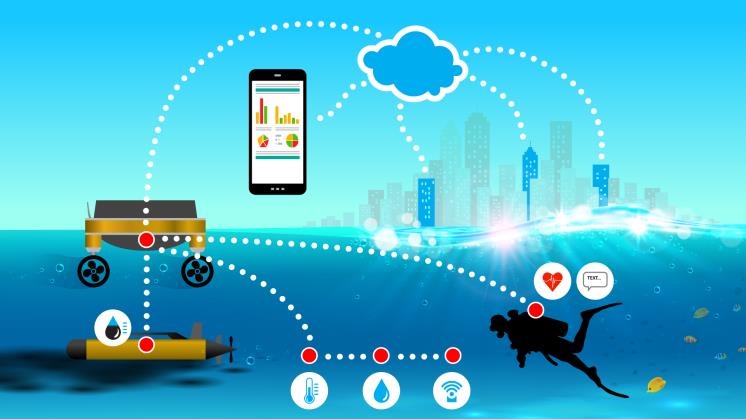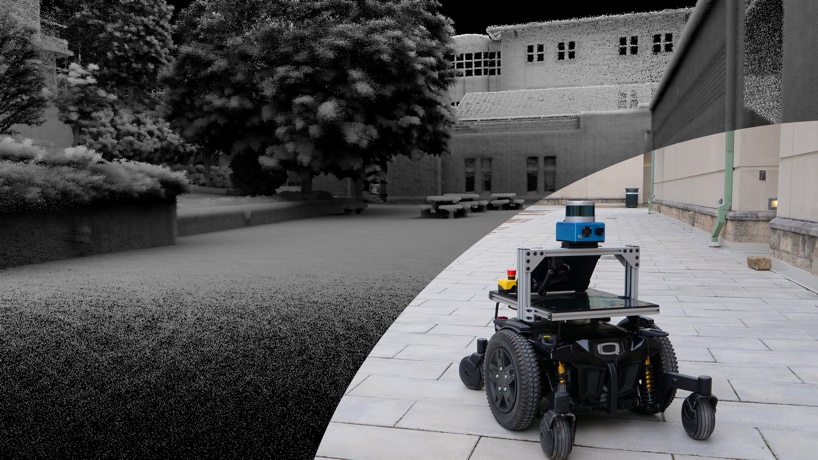Oceans to get better protection with connected underwater technology

Ocean divers could soon benefit from connected underwater technology. © Kirk Wester, Shutterstock.com
By Helen Massy-Beresford
Imagine seals swimming in the sea with electronic tags that send real-time water data to scientists back in their laboratories. Or archaeologists near a coast being automatically alerted when a diver trespasses on a precious shipwreck.
Such scenarios are becoming possible as a result of underwater connected technologies, which can help monitor and protect the world’s oceans. They can also shed light on the many remaining mysteries of the sea.
New frontier
‘A lot of funding has been provided to companies and institutions exploring space, but we have oceans around us that we have not explored,’ said Vladimir Djapic, innovation associate at the EU-funded TEUTA project.
“We have oceans around us that we have not explored.”
– Vladimir Djapic, TEUTA
Around 70% of the Earth is covered by oceans and more than four-fifths of them have never been mapped, explored or even seen by humans.
The Internet of Underwater Things, or IoUT, is a network of smart, interconnected sensors and devices to make communicating in the sea easier. It contrasts with the Internet of Things, or IoT, covering everything from smart phones to devices that allow people to switch on home heating remotely,
TEUTA ran from October 2020 through March 2022. It helped a Croatian company, H20 Robotics, develop and sell lightweight low-cost acoustic devices and robotic platforms for underwater wireless networks.
‘With a limited number of underwater network installations before, we could only explore limited coastal areas,’ said Djapic, who is chief executive officer of Zagreb-based H20 Robotics.
Advances in underwater technologies are expected to transform many sectors including marine biology, environmental monitoring, construction and geology.
Whale-like ways
TEUTA developed acoustic technology, which mimics the way whales and dolphins communicate.
Acoustic waves, unlike radio or optical communication ones, travel long distances underwater regardless of whether it is murky or clear.
Remote sensors, measuring tools, detection systems or cameras set up at an underwater site gather data then sent to a buoy on the surface. The buoy in turn sends the information wirelessly back to base, via the cloud, without the need for communication cables.
One focus area is improving communications between divers and land-based colleagues, according to Djapic.
‘For example, a diver working in underwater construction can send a message to a supervisor and request additional help or tools or similar,’ said Djapic.

Improved underwater communications will help connect land and sea, © H2O ROBOTICS, 2023
Scientists also stand to benefit by, for example, being able to remotely turn on a water-quality measuring device installed on the seabed from their labs.
For their part, archaeologists could use the technology to help protect vulnerable underwater sites with intruder-detection technology installed in remote locations.
Indeed, TEUTA technology will support another EU-backed project, TECTONIC, seeking to improve the documentation and protection of underwater cultural heritage at three pilot sites.
The sites are the Capo Rizzuto Marine Protected Area in southern Italy, the submerged ancient harbour of Aegina in Greece’s Saronic Gulf and a shipwreck site in the Deseado estuary in Argentina.
Other possibilities such as underwater agriculture or mining could also open up, according to Djapic.
For public agencies or non-governmental organisations that monitor water quality, the technology could replace the need for researchers to go and collect samples physically and deliver them to the lab.
While TEUTA gave a boost to fledgling underwater communication technologies, more work needs to be done in marketing them and ensuring they are used more widely, according to Djapic.
‘It all needs to be analysed,’ he said. ‘Our technology enables the measuring of environmental parameters.’
Sensors and samplers
Meanwhile, in Italy, a team of researchers is pursuing a new approach to ocean-data collection by using sensors and samplers that could be integrated into existing observatories and platforms.
This would enable the gathering of vast amounts of information useful for, as an example, the proposed European Digital Twin of the Ocean announced in February 2022. The twin will be a real-time digital replica of the ocean integrating both historical and live data.
By developing a new generation of marine technologies, the EU-funded NAUTILOS project will gather previously inaccessible information and improve understanding of physical, chemical and biological changes in oceans.
“They are the largest habitats on Earth, but the least observed.”
– Gabriele Pieri, NAUTILOS
Running for four years through September 2024, the project is coordinated by Gabriele Pieri of the Rome-based National Research Council.
‘Our proposal set out to fill a gap in the observation of oceans,’ said Pieri. ‘They are the largest habitats on Earth, but the least observed ones because of the difficulties in on-site observation and the costs of monitoring.’
NAUTILOS technology is already being tested in the Baltic and the Mediterranean seas, including the Aegean and Adriatic.
Sensors can, for example, measure levels of chlorophyll-A and dissolved oxygen in the water. These are important indicators of water quality and, by extension, of the presence of fish, helping protect their stocks.
Sensors and samplers collecting information about the concentration of microplastics in the water also expand understanding of the impact of human-generated pollution on the oceans.
Helping flippers and hands
One of the NAUTILOS partners, France’s National Centre for Scientific Research (CNRS), has even recruited some unlikely teammates: seals.
Swimming off the Valdes Peninsula in Argentina, these sea creatures have been tagged with sensors that record valuable data about the animals themselves and their habitats.
The NAUTILOS team, made up of research institutions and companies, is developing more than a dozen types of sensors and samplers. These include remote sensing technologies and microplastics detectors.
The project is keen to demonstrate that the new tools can work with existing and future platforms and easily switch between them.
The tools are relatively cheap, can be deployed quickly and work in conjunction with other equipment, offering many advantages. For example, a sensor can be mounted on an autonomous underwater vehicle and then moved to a fixed buoy.
Citizen science is an important part of NAUTILOS, which works with volunteers organising campaigns around ocean plastics, for example, as well as with scuba-diving associations whose members can test new technologies and offer feedback.
The team has also developed a smartphone app for divers to upload photos of underwater flora or fauna that can be assessed by researchers.
‘The interest in citizen science has really surprised me,’ said Pieri. ‘A lot of people are willing to help improve the life of the sea.’
Research in this article was funded by the EU and via the EU’s Marie Skłodowska-Curie Actions (MSCA). If you liked this article, please consider sharing it on social media.
This article was originally published in Horizon, the EU Research and Innovation magazine.
Enabling autonomous exploration

CMU’s Autonomous Exploration Research Team has developed a suite of robotic systems and planners enabling robots to explore more quickly, probe the darkest corners of unknown environments, and create more accurate and detailed maps — all without human help.
By Aaron Aupperlee
A research group in Carnegie Mellon University’s Robotics Institute is creating the next generation of explorers — robots.
The Autonomous Exploration Research Team has developed a suite of robotic systems and planners enabling robots to explore more quickly, probe the darkest corners of unknown environments, and create more accurate and detailed maps. The systems allow robots to do all this autonomously, finding their way and creating a map without human intervention.
“You can set it in any environment, like a department store or a residential building after a disaster, and off it goes,” said Ji Zhang, a systems scientist in the Robotics Institute. “It builds the map in real-time, and while it explores, it figures out where it wants to go next. You can see everything on the map. You don’t even have to step into the space. Just let the robots explore and map the environment.”
The team has worked on exploration systems for more than three years. They’ve explored and mapped several underground mines, a parking garage, the Cohon University Center, and several other indoor and outdoor locations on the CMU campus. The system’s computers and sensors can be attached to nearly any robotic platform, transforming it into a modern-day explorer. The group uses a modified motorized wheelchair and drones for much of its testing.
Robots can explore in three modes using the group’s systems. In one mode, a person can control the robot’s movements and direction while autonomous systems keep it from crashing into walls, ceilings or other objects. In another mode, a person can select a point on a map and the robot will navigate to that point. The third mode is pure exploration. The robot sets off on its own, investigates the entire space and creates a map.
“This is a very flexible system to use in many applications, from delivery to search-and-rescue,” said Howie Choset, a professor in the Robotics Institute.
The group combined a 3D scanning lidar sensor, forward-looking camera and inertial measurement unit sensors with an exploration algorithm to enable the robot to know where it is, where it has been and where it should go next. The resulting systems are substantially more efficient than previous approaches, creating more complete maps while reducing the algorithm run time by half.
The new systems work in low-light, treacherous conditions where communication is spotty, like caves, tunnels and abandoned structures. A version of the group’s exploration system powered Team Explorer, an entry from CMU and Oregon State University in DARPA’s Subterranean Challenge. Team Explorer placed fourth in the final competition but won the Most Sectors Explored Award for mapping more of the route than any other team.
“All of our work is open-sourced. We are not holding anything back. We want to strengthen society with the capabilities of building autonomous exploration robots,” said Chao Cao, a Ph.D. student in robotics and the lead operator for Team Explorer. “It’s a fundamental capability. Once you have it, you can do a lot more.”
The group’s most recent work appeared in Science Robotics, which published “Representation Granularity Enables Time-Efficient Autonomous Exploration in Large, Complex Worlds” online. Past work has received top awards at prestigious robotics conferences. “TARE: A Hierarchical Framework for Efficiently Exploring Complex 3D Environments” won the Best Paper and Best Systems Paper awards at the Robotics Science and Systems Conference in 2021. It was the first time in the conference’s history that a paper received both awards. “FAR Planner: Fast, Attemptable Route Planner Using Dynamic Visibility Update” won the Best Student Paper Award at the International Conference on Intelligent Robots and Systems in 2022.
More information is available on the group’s website.